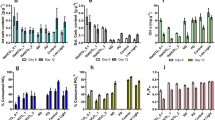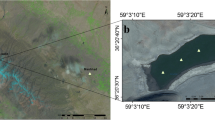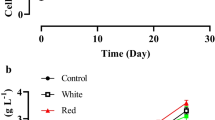Abstract
The growth and lipid content of three Botryococcus braunii strains from China (CHN), United Kingdom (UK) and Japan (JAP) were compared at three temperatures (20, 25 and 30 ∘C), three irradiances (60, 100 and 300 W m−2) and four salinities (0, 0.15, 0.25, and 0.5 M NaCl) for 30 days, respectively. In the temperature trial, the UK strain and JAP strain grew faster at 25 ∘C than at other temperatures, while the CHN strain performed equally well at 20 and 25 ∘C. The JAP strain grew slowest among the three strains at all temperatures, whereas the growth rate of the CHN and UK strains was similar at all temperatures except at 20 ∘C. The UK strain contained the highest lipid content, but the CHN strain had the lowest lipid content at most temperatures. In the light trial, the highest growth rate was found in the UK strain and the lowest growth rate was observed in the JAP strain at most irradiances. The UK and JAP strains contained more lipids than the CHN strain at 60 and 100 W m−2, but the lipid content was not significantly different among the three strains at 300 W m−2. In the salinity trial, both the CHN and UK strains grew faster than the JAP strain at all salinities, but the growth rate between the CHN and UK strains was not different. However, the CHN strain had the lowest lipid content whereas the UK strain produced the highest lipids at most salinities. Our results indicate that the CHN strain and the UK strain grow faster than the JAP strain, but the UK and JAP strains produce more lipids than the CHN strain. The UK strain should be considered as a potential B. braunii strain for the exploitation of renewable energy.
Similar content being viewed by others
References
Ben-Amotz A, Tornabene TG, Thomas WH (1985) Chemical profile of selected species of microalgae with emphasis on lipids. J. Phycol. 21: 72–81.
Casadevall E, Dif D, Largeau C, Gudin C, Chaument D, Desantit O (1985) Studies on batch and continuous cultures of Botryococcus braunii: hydrocarbon production in relation to physiological state, cell ultra structure, and phosphate nutrition. Biotechnol. Bioeng. 27: 286–295.
Cepák V, Lukavský J (1994) The effect of high irradiances on growth, biosynthetic activities and the ultrastructure of the green alga Botryococcus braunii strain Droop 1950/807-1. Arch. Hydrobiol. (Suppl.) 102: 115–131.
Derenne S, Metzger P, Largeau C, Van Bergen PF, Gatellier JP, Damste JSS, De Leeuw JW, Berkaloff C (1992) Similar morphological and chemical variations of Gloecapsomorpha prisca in Ordovician sediments and cultured Botryococcus braunii as a response to changes in salinity. Org. Geochem. 19: 299–313.
Fernandes HL, Tomè MM, Lupi F, Fialho AM, Sá-Correia I, Novais JM (1989) Biosynthesis of high concentrations of an exopolysaccharides during the cultivation of the microalga Botryococcus braunii. Biotechnol. Lett. 11: 433–436.
Huang XH, Li CL, Liu CW, Wang ZD, Chen JJ (2002) Studies on the N and P nutrient demand in Nannochloris oculata. Mar. Sci. (Chinese) 26: 13–17.
Inoue H, Korenaga T, Sagami H, Koyama T, Sugiyama H, Ogura K (1994) Formation of farnesyl oleate and three other farnesyl fatty acid esters by cell-free extracts from Botryococcus braunii B race. Phytochemistry 36: 1203–1207.
Komárek J, Marvan P (1992) Morphological differences in natural populations of the genus Botryococcus (Chlorophyceae). Arch. Protistenkd. 141: 65–100.
Largeau C, Casadevall E, Dif D, Berkaloff C (1980) Renewable hydrocarbon production from the agla Botryococcus braunii. In: Paiz W, Coombs J and Hall DO (ed.) Energy from Biomass. Elsevier Appl. Sci. Pub., London. pp 653–658.
Lee SJ, Yoon B-D, Oh H-M (1998) Rapid methods for the determination of lipid from the green Botryococcus braunii. Biotechnol. Tech. 12: 553–556.
Lupi FM, Fernandes HML, Sa-Correia I, Novais JM (1991) Temperature profiles of cellular growth and exopolysaccharide synthesis by Botryococcus braunii Kütz. UC58. J. Appl. Phycol. 3: 35–42.
Metzger P, Largeau C (2005) Botrococcus braunii: a rich source for hydrocarbons and related ether lipids. Appl. Microbiol. Biotechnol. 66: 486–496.
Nichols HW (1973) Growth media – freshwater. In Stein JR (ed.) Handbook of Phycological Methods: Culture Methods and Growth Measurements. Cambridge University Press, Cambridge. pp. 7–24.
Rafael VD, Bertha OAV (1991) Haloadaptation of the green alga Botyococcus braunii (Race A). Phytochem. 30: 2919–2925.
Sawayama S, InoueS, Yokoyama S (1994) Continuous culture of hydrocarbon-rich microalga Botryococcus braunii in secondarily treated sewage. Appl. Microbiol. Biotechnol. 41: 729-731.
Singh Y, Kumar HD (1994) Growth of Botryoccus spp. in improved culture medium. Phykos (India). 33: 77–87.
Townsend SA (2001) Perennial domination of phytoplankton by Botryococcus and Peridinium in a discontinuously polymictic reservoir (tropical Australia). Arch Hydrobiol. 151: 529–548.
Wang J, Yang SL, Cong W, Cai ZL (2003) Effect of nutrient conditions on the growth of Botryococcus braunii. Chin. J. Proc. Eng. 2: 141–145.
Wake LV, Hillen LW (1980) Study of a “bloom” of the oil-rich alga Botryococcus braunii in the Darwin River Reservoir. Biotechnol. Bioeng. 22: 1637–1656.
Wake LV, Hillen LW (1981) Nature and hydrocarbon content of blooms of the alga Botryococcus braunii occurring in Australian freshwater lakes. Aust. J. Mar. Freshwater. Res. 32: 353–367.
Yang S, Jun W, Wei C, Zhao LC, Fan QY (2004) Utilization of nitrite as a nitrogen source by Botryococcus braunii. Biotechnol. Lett. 26: 239–243.
Author information
Authors and Affiliations
Corresponding author
Rights and permissions
About this article
Cite this article
Li, Y., Qin, J.G. Comparison of growth and lipid content in three Botryococcus braunii strains. J Appl Phycol 17, 551–556 (2005). https://doi.org/10.1007/s10811-005-9005-7
Received:
Revised:
Accepted:
Published:
Issue Date:
DOI: https://doi.org/10.1007/s10811-005-9005-7




